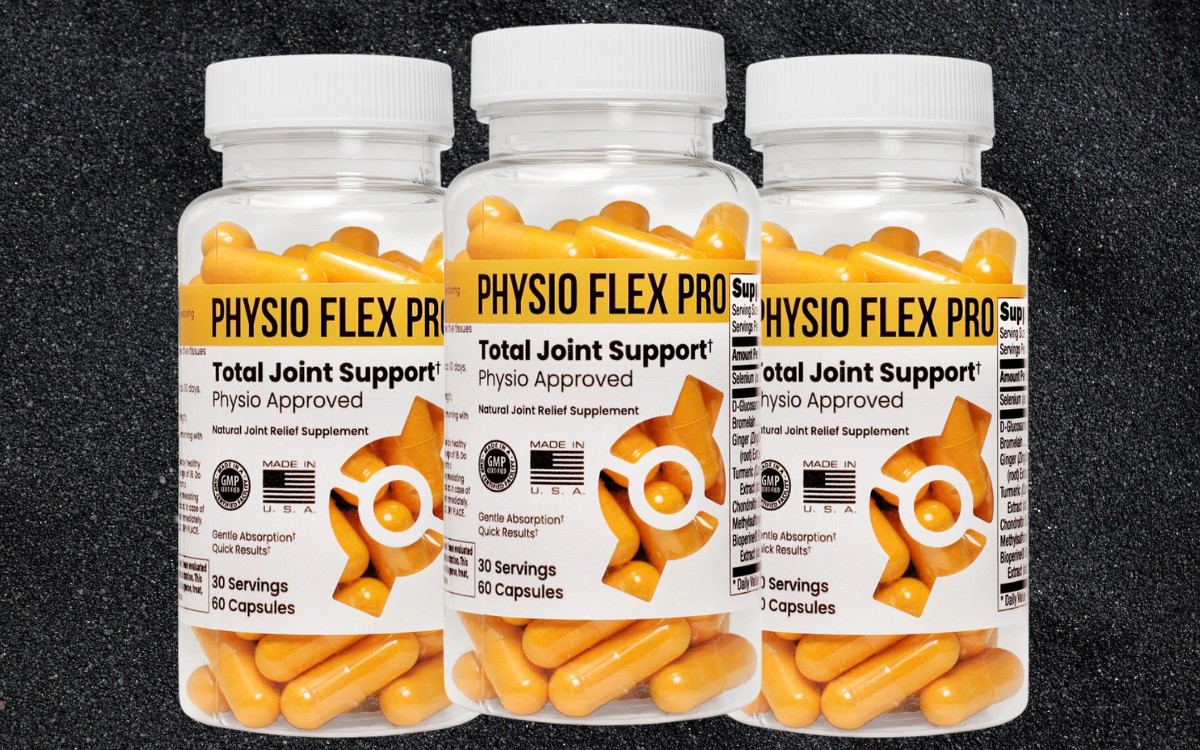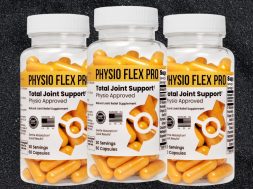
When you’re training hard, your joints take the beating long before your motivation does. Over the years, I’ve cycled through more joint stacks than I can count. Some help a little, and most are just expensive placebo blends with fancy branding.
Physio Flex Pro caught my attention because it’s been getting a fair bit of praise in the performance and rehabilitation world. It’s marketed as a “pharmaceutical-grade joint support formula”, built to improve mobility, reduce inflammation, and even support cartilage health long term.
So, I decided to run it through my usual test phase, which includes eight weeks of real training, normal workload, and no other joint supplements in the mix. The goal was to find out if Physio Flex Pro can actually do something noticeable, or if it’s another case of great marketing over modest science.
Quick Verdict
Physio Flex Pro is a clean, well-formulated product with a strong focus on natural anti-inflammatories like ginger, turmeric, and bromelain, plus structural support from glucosamine, chondroitin, and MSM. On paper, it covers the key angles of comfort, flexibility, and long-term joint health.
However, most of those core structural ingredients are underdosed compared to clinical research ranges.
You’re getting about a third (sometimes less) of what’s typically used in studies for osteoarthritis and cartilage repair.
That doesn’t make it useless, but it shifts its strength more toward short-term relief and inflammation control rather than full joint restoration.
For active men dealing with stiffness, post-workout soreness, or early signs of wear and tear, it might provide subtle comfort and smoother movement after a few weeks.
But if you’re chasing deeper, more structural results, FlexAgain still offers a better balance of clinical dosing and overall value.
Pros
- Transparent label; evidence-based actives (ginger, curcumin, bromelain, glucosamine, chondroitin, MSM, selenium, BioPerine).
- Piperine for absorption; gentle 2-capsule serving.
- Site shows 60-day money-back guarantee language.
- Strong on-site customer ratings
Cons
- Under-dosed versus common clinical ranges for glucosamine, chondroitin, MSM, and curcumin.
- Benefits likely skew toward mild symptom relief rather than major changes in joint function for most active users.
- Value swings with promos; alternatives at similar price points deliver higher totals per serving. (See comparison sections.)
What Is Physio Flex Pro?
Physio Flex Pro is a joint health supplement produced by SRS Nutra, a UK-based company known for making clean, research-backed formulations.
Each bottle contains 60 capsules, amounting to a one-month supply at two capsules per day, with eight active ingredients targeting joint lubrication, inflammation, and cartilage regeneration.
What separates it from your typical glucosamine pill is the inclusion of Bromelain, Ginger, and Turmeric, all of which have documented anti-inflammatory properties and can make a real difference in reducing stiffness and swelling after training or long workdays.
It also includes BioPerine, a black pepper extract that enhances nutrient absorption, and a small dose of Selenium, which supports connective tissue repair through its antioxidant role.
Essentially, Physio Flex Pro takes a hybrid approach: part anti-inflammatory, part joint-structure support, and part recovery booster. It’s positioned more as a “mobility enhancer” than a medical-strength cartilage rebuild formula.
Ingredients and Clinical Dosing Breakdown
Each two-capsule serving of Physio Flex Pro contains:
- Glucosamine HCl — 500 mg
- Bromelain — 300 mg
- Ginger Extract (5% Gingerols) — 250 mg
- Turmeric Extract (95% Curcuminoids) — 200 mg
- Chondroitin Sulfate — 100 mg
- MSM (Methylsulfonylmethane) — 100 mg
- Selenium (as Selenium Citrate) — 200 mcg
- BioPerine (Black Pepper Extract) — 10 mg
Let’s break down what each ingredient actually does and how the doses compare to the amounts used in human studies.
Glucosamine HCl — 500 mg
Glucosamine is one of the most established ingredients for joint support, especially for cartilage protection and osteoarthritis symptoms.
The majority of clinical studies use 1,500 mg daily, often in the sulfate form rather than hydrochloride (HCl). Research comparing the two forms suggests the sulfate version may be slightly more bioavailable.
At 500 mg, Physio Flex Pro delivers about one-third of the clinically studied dose and uses the less commonly preferred HCl form. You might still feel some benefit over time, particularly if your joints respond well to glucosamine in general, but for athletes with heavy workloads, this level is likely below optimal.
Chondroitin Sulfate — 100 mg
Chondroitin works synergistically with glucosamine to help rebuild and maintain cartilage structure. Effective doses in studies usually fall between 800 and 1,200 mg per day, which makes the 100 mg here relatively light.
This means it probably won’t deliver major structural repair on its own, though it may still provide mild lubrication benefits when paired with other compounds in the stack.
MSM (Methylsulfonylmethane) — 100 mg
MSM is a sulfur-based compound used to reduce inflammation and improve connective tissue elasticity. Most clinical trials showing significant results use 1,500–3,000 mg daily.
At 100 mg, Physio Flex Pro falls far below that mark, meaning it likely contributes more to the anti-inflammatory synergy of the blend than to any direct structural support.
Turmeric Extract (95% Curcuminoids) — 200 mg
Curcumin is one of the most well-researched natural anti-inflammatories available. Doses of 500–1,000 mg of curcuminoids have been shown to reduce pain and stiffness comparable to NSAIDs in some studies, particularly when paired with piperine for absorption.
Here, the 200 mg of 95% curcuminoids is on the lower side, but the 10 mg of BioPerine helps maximize absorption. So, while not clinical-strength, this combo may still deliver mild relief for chronic inflammation if used consistently.
Ginger Extract (5% Gingerols) — 250 mg
Ginger’s active compounds (gingerols) act as COX-2 inhibitors — the same pathway targeted by some pain medications. Studies suggest 500–1,000 mg of ginger extract can improve pain scores in knee osteoarthritis. At 250 mg, the dose is moderate but meaningful, especially when stacked with turmeric and bromelain.
Bromelain — 300 mg
Bromelain, derived from pineapple stem, is known for reducing swelling and aiding soft-tissue recovery. Most human studies use 500–1,000 mg daily for noticeable effects on joint pain or post-surgical swelling. The 300 mg here supports the overall anti-inflammatory action but is again below peak levels.
Selenium (as Selenium Citrate) — 200 mcg
A trace mineral involved in antioxidant enzyme production, selenium can indirectly protect joint tissue by limiting oxidative damage.
The 200 mcg dose here is perfectly reasonable and within the safe and effective range, particularly for athletes who sweat heavily and may run slightly low on micronutrients.
BioPerine (Black Pepper Extract) — 10 mg
BioPerine is included to improve the absorption of curcumin, ginger, and other phytonutrients. Ten milligrams is the standard clinically effective dose, so no complaints here.
Physio Flex Pro Price
Physio Flex Pro positions itself firmly in the premium bracket for joint health supplements. On the official website, pricing looks like this:
| Purchase Option | Price | Supply | Notes |
| Single Bottle | $80 (often discounted to $59) | 30 servings (1 month) | One-time purchase |
| Subscription | $39 per bottle | Recurring delivery | Cancel anytime |
At full retail ($80), it’s one of the more expensive joint supplements on the market, costing even more than many clinically dosed options like FlexAgain or ReliefFactor.
The subscription deal at $39 changes the math dramatically, cutting the price almost in half and putting it closer to typical mid-tier products.
The main drawback is that at the standard $59–80 price range, the dosages feel light relative to cost. You’re paying a premium for purity, convenience, and a well-rounded blend, not necessarily for clinical potency. Still, the company offers a 60-day money-back guarantee, which does soften the risk for first-time buyers.
Benefits of Physio Flex Pro
Mild Joint Pain and Stiffness Relief
The strongest short-term effects most users (and myself included) feel come from the anti-inflammatory trio of turmeric, ginger, and bromelain. These compounds help dampen everyday inflammation and stiffness, especially if your joints ache after intense sessions or long days on your feet.
Within two to three weeks, I noticed my knees feeling slightly looser during squats and morning stiffness dialed down a notch. The effect isn’t dramatic, but it’s consistent, and it feels clean, without the rebound pain you sometimes get from overusing NSAIDs.
Support for Recovery and Soft-Tissue Healing
Bromelain and MSM work synergistically to support recovery from minor strains and tendinitis. While the MSM dose here is modest, the addition of bromelain (300 mg) helps reduce post-training swelling and irritation in overused joints or connective tissue.
This is the kind of benefit you tend to appreciate quietly, delivering less nagging ache between sessions, easier warm-ups, and fewer “creaky” mornings.
Long-Term Joint and Cartilage Support
The combination of glucosamine, chondroitin, and MSM provides a foundation for maintaining cartilage integrity and joint cushioning.
At the current doses, you shouldn’t expect this formula to rebuild damaged cartilage, but it can slow down degradation and support overall joint health if taken consistently.
If you’ve been lifting or training for years and just want something to keep things from getting worse, this kind of background support matters.
Anti-Oxidative and Protective Effects
The addition of selenium and BioPerine gives Physio Flex Pro a small but meaningful antioxidant edge. Selenium helps protect joint tissues from oxidative stress, while BioPerine enhances the uptake of the entire formula.
Together, they make sure the actives actually do their job inside your system rather than passing straight through.
Who Is Physio Flex Pro For?
For Active Men in Their 30s–50s
If you’re training several times a week, Physio Flex Pro fits nicely as a maintenance supplement. It won’t overhaul your joints overnight, but it can help you move with less stiffness and reduce the slow accumulation of wear and tear that builds up over time.
For Those With Mild Joint Discomfort or Early-Stage Wear
If you’re feeling that early “tightness” or dull ache after workouts, or your knees don’t bounce back like they used to, this formula can help take the edge off. It’s also a solid option for guys recovering from joint-heavy sports or an injury phase, since the anti-inflammatories are gentle on the stomach and safe for long-term use.
For Men Who Want Simplicity and Clean Formulation
No messy scoop powders, no hidden blends, just two capsules a day with transparent labeling. That’s a big plus if you’re tired of guessing what’s in your supplements. The formula is also free of shellfish allergens, which is rare for glucosamine-based products.
Who It Isn’t For
Physio Flex Pro isn’t ideal for people expecting fast, clinical-grade results or those with advanced osteoarthritis. The glucosamine, chondroitin, and MSM doses are simply too low to match the improvements seen in long-term clinical trials.
If you’re looking for something to genuinely rebuild cartilage or relieve severe pain, FlexAgain or a targeted stack with higher structural doses will be the better investment.
My Experience With Physio Flex Pro
Over two months, I ran Physio Flex Pro alongside my normal training schedule, which includes four or five strength sessions per week, and two grappling practices, aside from chasing my mids around.
I didn’t change anything else in my recovery routine besides swapping out my previous joint stack to see how this one performed on its own.
For the first two weeks, there wasn’t much to report. Around week three, I started noticing subtle but real changes: the “morning crack” in my knees was quieter, and my elbows didn’t bark as much after long grip-heavy sessions. It wasn’t a night-and-day difference, but it felt smoother.
By week six, the biggest benefit was consistency. I could train back-to-back days without waking up stiff or swollen, which usually happens when I push heavy squats and wrestling in the same week.
The recovery between sessions just felt cleaner. On the flip side, my heavier lifts (especially deep squats and power cleans) didn’t suddenly feel like I’d discovered a new joint supplement miracle.
The deeper discomfort in my knees remained the same, which tells me the structural support ingredients aren’t doing much at their current doses.
Another plus is the gut comfort. Some joint formulas loaded with turmeric or boswellia can cause bloating or nausea, but Physio Flex Pro sat cleanly even on an empty stomach.
If I had to quantify it, I’d say Physio Flex Pro reduced my daily stiffness and post-session aches by maybe 15–20%, which is respectable for a supplement that leans natural and isn’t max-dosed.
But if I compare it to FlexAgain, that product’s higher concentrations of omega-3s, curcumin, and vitamin D provided a more noticeable long-term impact on both comfort and resilience.
Physio Flex Pro, though, wins on simplicity and gentleness and feels “cleaner” in the body and works well as a maintenance formula, especially for guys who don’t want to pop a handful of pills every day.
Customer Reviews
To get a broader sense of how it performs beyond my own experience, I dug into verified reviews on the Physio Flex Pro website and independent retailer platforms. On their official store, the supplement holds an average rating of around 4.7 out of 5 stars, with over a hundred customer entries.
The majority of reviews are positive. Common praise includes improved flexibility, easier recovery from gym sessions, and less morning pain. Many users mentioned noticing results after 3–4 weeks of consistent use. One verified buyer wrote:
“I’ve been taking Physio Flex Pro for six weeks and my knees have stopped clicking every time I walk up the stairs. It’s the first product that’s actually made a difference without upsetting my stomach.”
Another review from an older lifter said:
“I’m 52 and still lift heavy. This is one of the only joint supplements I’ve used that didn’t feel like snake oil. It won’t rebuild your joints, but it keeps them happier.”
That’s about the tone of the feedback overall — modest, consistent, and realistic. There are a few neutral or negative reviews too. A small number of users said they didn’t feel much difference even after a month, and a couple mentioned the price being hard to justify unless bought on subscription.
That’s fair because at $80 a bottle, it’s a steep buy if you’re not feeling tangible improvements.
Across independent review boards, the general sentiment matches my own experience: Physio Flex Pro helps with comfort and mobility, but it’s not a miracle fix. It’s best seen as a maintenance supplement rather than a therapeutic one.
Physio Flex Pro Side Effects
Overall, Physio Flex Pro is very well-tolerated. I didn’t experience any side effects during my 8-week trial, and most user reviews echo the same. There are a few reasons for that:
- The formula uses moderate doses and avoids harsh compounds or proprietary blends.
- There are no stimulants, no shellfish (unlike many glucosamine sources), and no artificial fillers.
- The inclusion of BioPerine and Selenium supports better absorption and antioxidant balance, which can reduce oxidative stress on the gut.
Potential mild side effects, while rare, could include minor bloating or nausea for those sensitive to turmeric or ginger. Taking the capsules with food eliminates that issue almost entirely.
It’s also worth noting that people on blood-thinning medications should check with their doctor before using Physio Flex Pro. Bromelain and turmeric can have mild anticoagulant effects, so that’s one combination to approach cautiously.
All in all, it’s one of the gentlest joint supplements I’ve used, both on the stomach and on overall system load.
Physio Flex Pro Alternatives
Move Free
The classic Move Free Advanced formula includes glucosamine (1,500 mg), chondroitin (200 mg), Uniflex (a proprietary mineral complex), and hyaluronic acid.
On paper, the glucosamine dose is solid, but the rest of the formula feels dated compared to newer products. The Uniflex blend isn’t well-documented in human trials, and while the chondroitin is there, it’s underdosed.
In my experience, Move Free provides modest comfort improvements for people with mild stiffness or early joint issues. It doesn’t do much for inflammation, and it lacks modern anti-inflammatory ingredients like turmeric, ginger, or bromelain. It’s more of a maintenance option for older adults or anyone looking for an inexpensive “base layer” supplement.
When compared to Physio Flex Pro, Move Free has the edge in glucosamine dosage, but falls behind in overall synergy and purity. Physio Flex Pro includes cleaner, inflammation-targeting compounds, which makes it more suitable for active men or athletes, even if the structural doses are lighter.
If price is the deciding factor, Move Free wins easily, typically around $25–35 per bottle. But if you want something that actually feels different in a few weeks, Physio Flex Pro is the better pick between the two.
You can read my complete Move Free review here.
FlexAgain
Where Physio Flex Pro goes for a minimalist 8-ingredient formula, FlexAgain takes a full-spectrum approach:
- Omega-3 fatty acids (1100 mg EPA/DHA)
- Curcumin (500 mg)
- Bromelain, Boswellia, Glucosamine, Chondroitin, Vitamin D, and Resveratrol, among others.
The difference is obvious when you look at dosing. FlexAgain’s ingredient levels are much closer to what’s been proven in clinical trials. The curcumin content alone is over twice as high as Physio Flex Pro’s, and it pairs it with additional anti-inflammatory agents like Boswellia serrata, which has strong evidence for reducing cartilage degradation.
In practical terms, when I ran FlexAgain for a full cycle, the effect was more pronounced. Around the three-week mark, the post-lift soreness and “joint heaviness” after squats or grappling drills started easing up.
It didn’t eliminate pain, but it significantly improved comfort and joint fluidity. After six to eight weeks, the improvement was more structural, which i felt as not just reduced inflammation, but better range and recovery.
Physio Flex Pro feels cleaner and easier to take with two capsules a day vs. FlexAgain’s multi-pill regimen, but FlexAgain simply works better. The higher doses of omega-3s and anti-inflammatory compounds move the needle more.
If I had to recommend one overall, FlexAgain is the superior product for serious athletes or men in their 30s–50s who lift and move hard. Physio Flex Pro would suit someone who wants a simpler, milder, more gut-friendly option, but if your goal is true performance-level joint support, FlexAgain still sits at the top.
Joint Food
Joint Food by ATP Science takes a different route altogether. Instead of stacking common ingredients like glucosamine and MSM, it focuses on nutritional cofactors and collagen-building nutrients with things like glycine, proline, lysine, and cofactors that stimulate your body’s own collagen synthesis.
This makes Joint Food more of a tissue-rebuilding product than an inflammation-control one. It’s not something you’ll “feel” immediately, but it supports the long game: tendon strength, connective tissue integrity, and long-term recovery capacity.
When I tested it, the results were more subtle but real with fewer tweaks and strains over time, and better overall tissue resilience. It also paired nicely with my collagen powder, amplifying its effects.
Compared to Physio Flex Pro, Joint Food lacks the instant anti-inflammatory punch, but over time it supports the deeper architecture of your joints in a way most over-the-counter supplements can’t.
So if your training style leans toward explosive, high-impact sports (grappling, sprinting, CrossFit, weightlifting), Joint Food can be an excellent companion product, best taken alongside something like Physio Flex Pro or FlexAgain for the inflammation side.
My Joint Food review goes into more detail about the formulation and my experience.
Frequently Asked Questions About Physio Flex Pro
How long before I see results?
Most users start to feel subtle changes after about 3 to 4 weeks of consistent use, mainly reduced stiffness and better mobility in the morning.
For noticeable relief or deeper recovery benefits, 6 to 8 weeks is a more realistic timeframe. Like most joint supplements, it’s a slow-build product, not an instant fix. Consistency matters more than timing your dose.
Can I take it with other supplements?
Yes. Physio Flex Pro stacks well with most daily supplements, especially fish oil, collagen, or vitamin D. Just avoid doubling up on glucosamine or chondroitin from another joint product, because that’s unnecessary overlap and won’t accelerate results.
If you’re taking blood thinners, check with your doctor first since bromelain and turmeric can have mild anticoagulant effects.
Will it cure my arthritis?
No, and to their credit, the company doesn’t make that claim. Physio Flex Pro isn’t a medical treatment; it’s a nutritional support supplement meant to reduce inflammation, improve comfort, and slow down joint wear over time. It can help manage mild osteoarthritis symptoms, but won’t reverse cartilage loss or replace proper therapy.
Is the money-back guarantee legitimate?
Yes. Physio Flex Pro offers a 60-day money-back guarantee through its official website. You’ll need to contact their support team within that window if you’re not satisfied.
It’s straightforward and doesn’t require returning empty bottles, which is a good sign that the company stands behind the product.
Summary
After two months of testing, Physio Flex Pro left a clear impression. It’s one of the cleanest, most tolerable joint supplements I’ve used, but not the most powerful.
It shines in its natural anti-inflammatory blend, including turmeric, ginger, and bromelain, which work together to noticeably reduce everyday stiffness and soreness.
It’s easy on the stomach, simple to take, and built with transparency in mind. The downside is that its structural support ingredients (glucosamine, chondroitin, MSM) are underdosed compared to what’s been shown effective in clinical research. So while you’ll likely move a little easier, it won’t rebuild your joints from the ground up.
At its discounted $39 subscription price, it becomes a respectable maintenance option, but at the full $80 retail, it’s harder to justify against better-dosed competitors like FlexAgain.
If I had to pick between them, FlexAgain is the stronger all-rounder. Its higher doses of omega-3s, curcumin, boswellia, and vitamin D make it a more complete formula for joint performance, recovery, and long-term health.
Physio Flex Pro is the cleaner, lighter version, making it better for men who prefer a simple, natural product that won’t upset digestion or interact with other supplements.
Best Joint Pain Supplement
FlexAgain
A powerful, clinically dosed joint supplement to alleviate joint pain and improve joint health.
CHECK CURRENT DEALS














